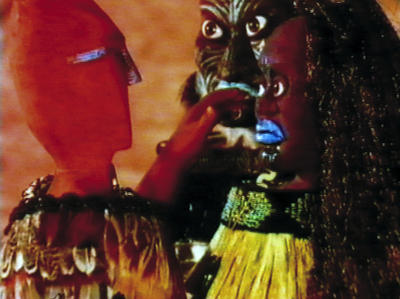Digital Marae: Maui
-
Lisa Reihana
b.1964
Ngā Puhi, Māori
Ngāti Hine, Māori
Ngāi Tu, Māori

Title
Digital Marae: Maui
Details
| Production Date | 2007 |
|---|---|
| Collection(s) | Collection Govett-Brewster Art Gallery, New Plymouth. Acquired with assistance from the Govett-Brewster Foundation. |
| Accession Number | 2008/5 |
| Media | Colour digital print on aluminium |
| Measurements | 2000 x 1200mm |
About
Lisa Reihana has contributed in powerful ways to multimedia and screen culture in New Zealand. In Digital Marae, one of her major ongoing projects inaugurated in 1995, Reihana explores Māori ancestral figures traditionally found on the marae, the central site of any traditional Maori community life where people congregate to discuss and debate local affairs and conduct ceremonies. The marae is imbued with strong customs and sense of place. Reihana’s life-size photographs are a contemporary take on pouwhenua, the wooden carvings found lining the interior of the wharenui or meeting house.
With the lyricism of magic realism, Reihana’s digital photographs seamlessly fuse traditional and contemporary motifs and offer new representations of Māori ancestral figures that convey the complex narratives of Māori mythology to make it accessible to global audiences. Furthermore, by incorporating varied identities Reihana’s Digital Marae echoes the desire for an inclusive contemporary marae that would interpret mythology and re-examine Maori identity itself. The photographs Dandy, Hinepukohurangi, Maui and Marakihau, all produced in 2007, reflect a significant moment in the development of Reihana’s Digital Marae, with the inclusion of male and takatāpui — a devoted partner of the same sex — and cross-gendered figures, expanding on her existing repertoire of arrestingly beautiful female forms.
The play of colour, texture, movement, costumes and props confer a distinctive character and feeling to each subject and the worlds they inhabit. The glossy finish of the digital print mounted in aluminium mimics their highly polished surfaces. Reihana sees these figures as sculptures, as physical photographic carvings representing the ancestors formally carved in pounamu and wood.
Reihana describes each of the figures as follows:
“Māui is also a demi-god and a shape shifter well known throughout the Pacific. He has strong associations with the sea. It was great to work with Charles Koroneho, an amazing artist and performer with the MAU dance collection, and easy because he is also Ngāpuhi. Māui is usually depicted undertaking one of his many daring feats, but I didn’t want a testosterone fuelled look. The dynamic surfing stance was inspired by a 1970s National Geographic image. When I found this visual reference I knew I’d cracked it. Once Māui was completed it allowed me to consider undertaking the other male atua and my other concern to include a place in my wharenui for takatāpui.”


